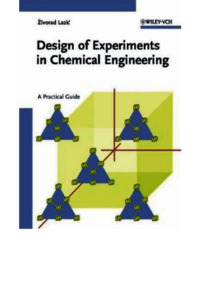Autor "Gavin Henrick"
Se han encontrado 1 Coincidencias
Design of Experiments in Chemical Engineering
25 Visitas | 108 Descargas | 2015-01-31 20:54:48 | raulito
The last twenty years of the last millennium are characterized by complex automatization of industrial plants. Complex automatization of industrial plants means a switch to factories, automatons, robots and self adaptive optimization systems. The mentioned processes can be intensified by introducing mathematical methods into all physical and chemical processes. By being acquainted with the mathematical model of a process it is possible to control it, maintain it at an optimal level, provide maximal yield of the product, and obtain the product at a minimal cost. Statistical methods in mathematical modeling of a process should not be opposed to traditional theoretical methods of complete theoretical studies of a phenomenon. The higher the theoretical level of knowledge the more efficient is the application of statistical methods like design of experiment (DOE). To design an experiment means to choose the optimal experiment design to be used simultaneously for varying all the analyzed factors. By designing an experiment one gets more precise data and more complete information on a studied phenomenon with a minimal number of experiments and the lowest possible material costs. The development of statistical methods for data analysis, combined with development of computers, has revolutionized the research and development work in all domains of human activities. Due to the fact that statistical methods are abstract and insufficiently known to all researchers, the first chapter offers the basics of statistical analysis with actual examples, physical interpretations and solutions to problems. Basic probability distributions with statistical estimations and with testings of null hypotheses are demonstrated. A detailed analysis of variance (ANOVA) has been done for screening of factors according to the significances of their effects on system responses. For statistical modeling of significant factors by linear and nonlinear regressions a sufficient time has been dedicated to regression analysis. Introduction to design of experiments (DOE) offers an original comparison between so-called classical experimental design (one factor at a time-OFAT) and statistically designed experiments (DOE). Depending on the research objective and subject, screening experiments (preliminary ranking of the factors, method of random balance, completely randomized block design, Latin squares, Graeco-Latin squares, Youdens squares) then basic experiments (full factorial experiments, fractional factorial experiments) and designs of second order (rotatable, D-optimality, orthogonal, B-designs, Hartleys designs) have been analyzed. For studies with objectives of reaching optima, of particular importance are the chapters dealing with experimental attaining of an optimum by the gradient method of steepest ascent and the nongradient simplex method. In the optimum zone up to the response surface, i.e. response function, one can reach it by applying secondorder designs. By elaborating results of second-order design one can obtain square regression models the analysis of which is shown in the chapter on canonical analysis of the response surface. The third section of the book has been dedicated to studies in the mixture design field. The methodology of approaching studies has been kept in this field too. One begins with screening experiments (simplex lattice screening designs, extreme vertices designs of mixture experiments as screening designs) through simplex lattice design, Scheffe's simplex lattice design, simplex centroid design, extreme vertices design, D-optimal design, Draper-Lawrence design, full factorial mixture design, and one ends with factorial designs of process factors that are combined with mixture design so-called "crossed" designs. The significance of mixture design for developing new materials should be particularly stressed. The book is meant for all experts who are engaged in research, development and process control.
Contribuir
Usted puede contribuir con Libros UCLV, es importante para nosotros su aporte..
Contribuir